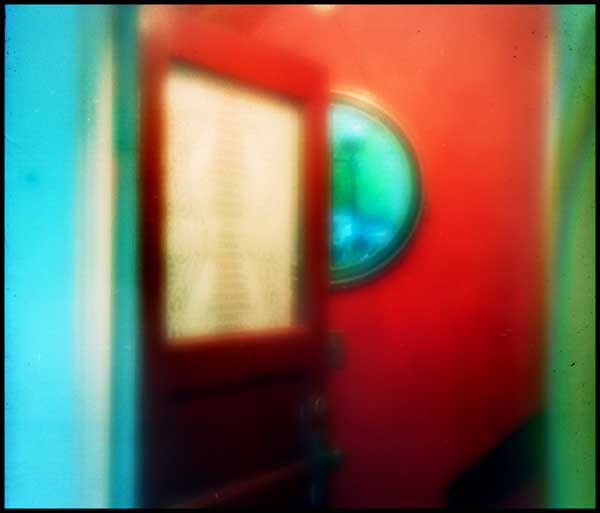One thing that's notable about the current world of pinhole photography is that it has become dominated by the use of cameras that have been purchased rather than made by the photographer. On Facebook and Twitter anyway, it's less frequent to see someone using a camera they've made or modified themselves, or even drilled their own pinhole.
I've got nothing against this practice and I admire the small-scale craftsmanship of the people who make and sell these cameras, but I've never used one myself. I've only taken photographs with a lensless camera I didn't make myself a few times.
Occasionally in workshops I would take pictures with cameras the participants built to test that light leaks had been successfully overcome. In The Pinhole of Nature, I included a Camera Portrait with Self done with a camera made by a 6th grader that was left behind after a workshop.
I shot half a roll in my Canon F-1 but I did make the bodycap and pinhole. When I was working with Barnes and Noble on their version of the Populist, they sent me a P-Sharan as an example of what they wanted to compete with and I shot one roll with that.
A couple times, someone organized a project where a camera was sent from one photographer to another. As part of his Pinhole Geocaching project, Pinhole Doug sent around an Argus C-3 with a pinhole on it that each participant took one frame with.
The most notable example was a traveling camera that didn't have a pinhole - it had a pinhole sieve.
For those of you who have never heard these terms, a zone plate is a piece of opaque graphic arts film with special pattern of concentric circles. A pinhole sieve is a similar device with the circles replaced by a pattern of pinholes. The driving force behind both of these ideas is to deliver more light to the film than a single pinhole. The disadvantage, or charm depending on how you're looking at it, is that the images include a significant amount of diffraction which provides a particular diffuse glow to the images. Although the optimal size of a pinhole is correlated to the distance from the film, zone plates and sieves have a specified focal length and the already diffuse image degrades very quickly away from the distance it was designed for.
That's another difference I've noted lately. I haven't seen anyone post a picture done with a zone plate or a pinhole sieve for years. On f295, there were forums dedicated to zone plate photography, that although not as active as the pinhole forums, had fairly regular contributions.
Daryl Duckworth from Pennsylvania was a particularly eccentric member of the f295 forum. The location on his profile was Earth. He also had a second account in the guise of the drill sargent Sarge who would demand in all caps that everyone shoot more film and submit pinhole images to lens based contests and exhibits. He was a prolific modifier of cameras.
On a 6x6cm camera that was covered in red leatherette, he replaced the lens with a pinhole sieve which he dubbed the Lady in Red. I don't remember and can't find anything on f295 where he or anyone else specified what the camera was, except that it was 90mm. Maybe one of the forum members who remembers will read this and let us know. After posting pictures with it for several months he offered to send it around to anyone who'd like to try it out. I signed up.
I shot two rolls of film with it submitted in two separate posts.
The first was posted under the title The Lady in Red in Oshkosh on September 6, 2006.
Here are five from Daryl's fancy lady.
Fuji realia 100.
The door is a combination of late evening sunlight and tungsten. Don't remember the exposure, but it was long.
The brushes were a pretty short exposure, about 4 seconds
The faucet quite long, about three minutes. I started the exposure and the sun went behind a cloud so I just left it open until the sun came back and then exposed for what I'd measured originally, a minute and a half. Got seduced by the viewfinder and kept forgetting about parallax.
One last one- I put her on the ground to face the similarly outfitted habaneros. Also about a minute and a half.
BTW, these are all from one roll.
I'll probably send her off to Eddie now. I did buy a second roll, but think I'll make a cardboard 6 x 12 for that.
I changed by mind and also shot that second roll with the pinhole sieve camera and posted under the title More from the Lady in Red on October 10, 2006.
Five from my second roll through the lady in red.
The white clematis was about as fast as I could open and close the shutter.
The habaneros about 12 seconds.
Sculpture - a minute and a half.
Yellow tree about a half second.
And my favorite of the lot, my trusty south kitchen window, 12 seconds.











No comments:
Post a Comment